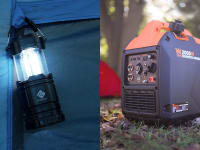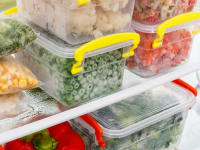This refrigerator hack could keep you safe during a power outage
All you need is a coin and a cup.
Products are chosen independently by our editors. Purchases made through our links may earn us a commission.
Whether it's a blizzard, a hurricane, or another strong storm, power outages can happen and may even be expected depending on the severity of incoming weather. When a power outage happens, there isn't much you can do but wait for it to be restored. And if it's out for a long period of time, it can really put a damper on your food supply by spoiling your refrigerated items. That is unless you have a backup generator.
However, if you need to evacuate due to an incoming storm, like Hurricane Ian, you won't have a backup generator running in your absence and you may not know if or for how long the power was out upon your return, leaving you guessing if your food has spoiled or not. Fortunately, you can use this Facebook user's brilliant tip that has gone viral. Sheila's hack is quite simple: All you have to do is freeze a cup of water, then put it in the refrigerator with a quarter on top of it before you leave your home.
How to tell if your food is safe to eat after you lose power

Make sure the water is completely frozen first.
Unfortunately, if the power goes out for an extended period of time, you run the risk of food going bad.
Once the power is restored, use a food thermometer if you have one on hand to measure the temperature of the food in the fridge—the FDA says food under 45 degrees Fahrenheit or below is safe to consume if the power was out for no more than four hours.
If you're evacuating and won't be home to supervise your home's power, that's where the "quarter on a cup" method comes in.
Does the "quarter on a cup" method work?
We asked our senior manager of lab operations, Jon Chan, to explain the logic behind what he calls a tried-and-true method. "If the quarter is on top, you're fine, but if it's more than half an inch down, your food has been exposed to warm temperatures for a prolonged period of time," he says.
According to Jon, who calls it both reliable and smart, yes. "If you leave your home and return, you do not have any indication of how long a power outage has lasted, only that one has occurred," he explains, adding, "This is a good trick not just for storm season, but for whenever you leave your house for more than a few days."
Of course, Jon also notes that when in doubt, always throw food out just to be safe. If you aren't sure if the power went out—and that your food may have refrozen without you realizing—err on the side of caution to avoid eating potentially spoiled food.
Other tips to keep your food safe during a power outage
Jon's best—and easiest—advice? "Keep the door to the fridge closed as much as possible," he says. "Fridges are designed to be well insulated. The vast majority of fridges we test are able to keep a safe temperature for over 48 hours if the door remains closed."
And speaking of your refrigerator's temperature, follow this rule of thumb from the USDA: They recommend that you throw away dairy products, meats, fish, soft cheeses, or cooked vegetables if they're kept at 40 degrees or warmer for more than two hours.
More on refrigerators
- The Best Refrigerators We've Tested
- How cold should your refrigerator be?
- The surprising perks of bottom-freezer refrigerators
- What fridge style fits you best? Read this before you buy
- The Best French-Door Refrigerators We've Tested
- 4 best garage refrigerators to store extra drinks and food
- How we test refrigerators in the Reviewed test labs
- The Best Side-by-side Refrigerators We've Tested
- The Best Top-Freezer Refrigerators We've Tested
- The Best Counter-Depth Refrigerators We've Tested



